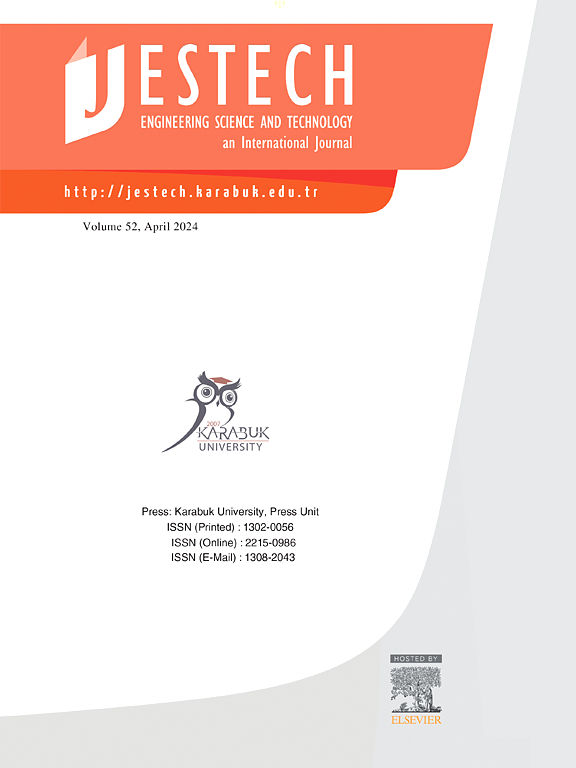Memory-driven deep-reinforcement learning for autonomous robot navigation in partially observable environments
IF 5.1
2区 工程技术
Q1 ENGINEERING, MULTIDISCIPLINARY
Engineering Science and Technology-An International Journal-Jestech
Pub Date : 2025-02-01
DOI:10.1016/j.jestch.2024.101942
引用次数: 0
Abstract
Service robots with autonomous navigational capabilities play a critical role in dynamic contexts where safe and collision-free human interactions are important. However, the unpredictable nature of human behavior, the prevalence of occlusions and the lack of complete environmental perception due to sensor limitations can severely restrict effective robot navigation. We propose a memory-driven algorithm that employs deep reinforcement learning to enable collision-free proactive navigation in partially observable environments. The proposed method takes the relative states of humans within a limited FoV and sensor range as input into the neural network. The model employs a bidirectional gated recurrent unit as a temporal function to strategically incorporate the previous context of input sequences and facilitate the assimilation of the observations. This approach allows the model to assign greater attention to intricate human–robot relations, allowing a better understanding of the ever-changing dynamics within an environment. Simulations and experimental outcomes validate the efficacy of the policy-based navigation approach. It achieves superior collision avoidance performance compared to representative existing methods and exhibits efficient navigation by incorporating the limitations of sensors during training.
部分可观察环境下自主机器人导航的记忆驱动深度强化学习
具有自主导航能力的服务机器人在动态环境中发挥着至关重要的作用,在动态环境中,安全和无碰撞的人类交互非常重要。然而,人类行为的不可预测性、闭塞的普遍性以及由于传感器的限制而缺乏完整的环境感知,都严重限制了机器人的有效导航。我们提出了一种内存驱动的算法,该算法采用深度强化学习,在部分可观察的环境中实现无碰撞的主动导航。该方法将人类在有限视场和传感器范围内的相对状态作为神经网络的输入。该模型采用双向门控循环单元作为时间函数,策略性地结合输入序列的先前上下文,并促进观测结果的同化。这种方法使模型能够更多地关注复杂的人机关系,从而更好地理解环境中不断变化的动态。仿真和实验结果验证了基于策略的导航方法的有效性。与代表性的现有方法相比,该方法实现了优越的避碰性能,并在训练过程中结合传感器的局限性,展示了高效的导航。
本文章由计算机程序翻译,如有差异,请以英文原文为准。
求助全文
约1分钟内获得全文
求助全文
来源期刊

Engineering Science and Technology-An International Journal-Jestech
Materials Science-Electronic, Optical and Magnetic Materials
CiteScore
11.20
自引率
3.50%
发文量
153
审稿时长
22 days
期刊介绍:
Engineering Science and Technology, an International Journal (JESTECH) (formerly Technology), a peer-reviewed quarterly engineering journal, publishes both theoretical and experimental high quality papers of permanent interest, not previously published in journals, in the field of engineering and applied science which aims to promote the theory and practice of technology and engineering. In addition to peer-reviewed original research papers, the Editorial Board welcomes original research reports, state-of-the-art reviews and communications in the broadly defined field of engineering science and technology.
The scope of JESTECH includes a wide spectrum of subjects including:
-Electrical/Electronics and Computer Engineering (Biomedical Engineering and Instrumentation; Coding, Cryptography, and Information Protection; Communications, Networks, Mobile Computing and Distributed Systems; Compilers and Operating Systems; Computer Architecture, Parallel Processing, and Dependability; Computer Vision and Robotics; Control Theory; Electromagnetic Waves, Microwave Techniques and Antennas; Embedded Systems; Integrated Circuits, VLSI Design, Testing, and CAD; Microelectromechanical Systems; Microelectronics, and Electronic Devices and Circuits; Power, Energy and Energy Conversion Systems; Signal, Image, and Speech Processing)
-Mechanical and Civil Engineering (Automotive Technologies; Biomechanics; Construction Materials; Design and Manufacturing; Dynamics and Control; Energy Generation, Utilization, Conversion, and Storage; Fluid Mechanics and Hydraulics; Heat and Mass Transfer; Micro-Nano Sciences; Renewable and Sustainable Energy Technologies; Robotics and Mechatronics; Solid Mechanics and Structure; Thermal Sciences)
-Metallurgical and Materials Engineering (Advanced Materials Science; Biomaterials; Ceramic and Inorgnanic Materials; Electronic-Magnetic Materials; Energy and Environment; Materials Characterizastion; Metallurgy; Polymers and Nanocomposites)
 求助内容:
求助内容: 应助结果提醒方式:
应助结果提醒方式:


